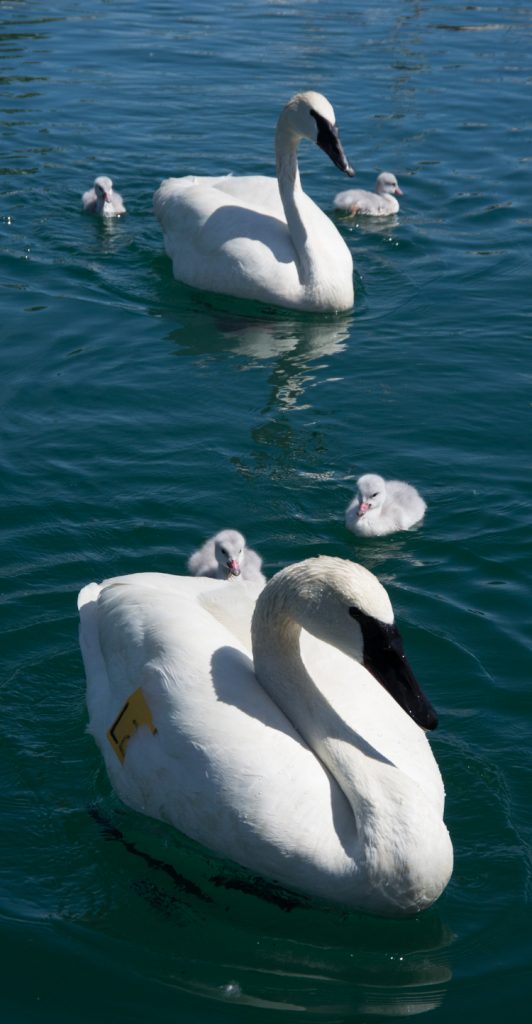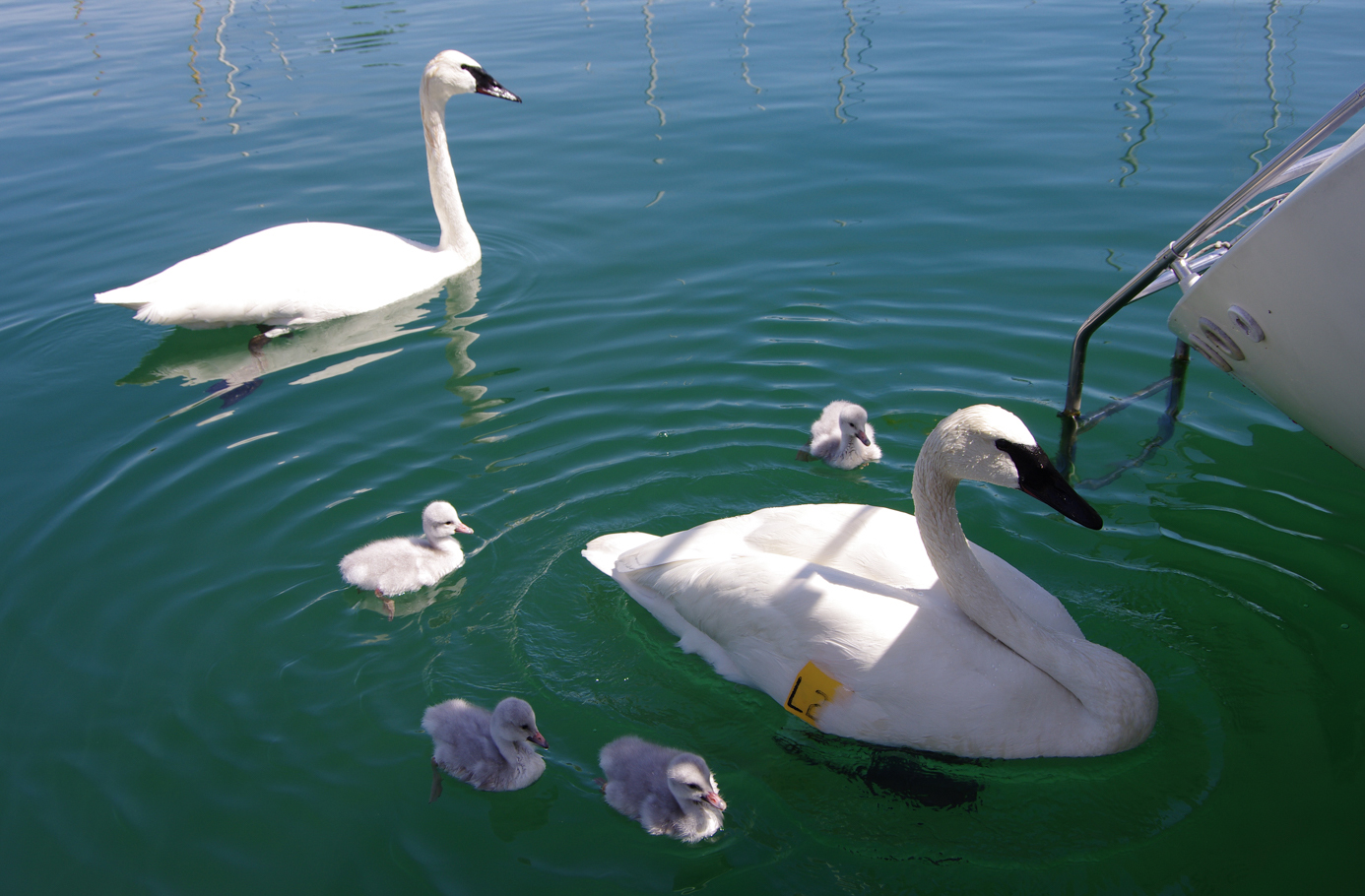Guest article by Lynne Jones, Secretary, Bluffers Park Yacht Club
The largest swan in the world, the Trumpeter Swan, is native only to North America. Once hundreds of thousands of pairs of these birds nested in the northern areas of Canada and the U.S. in the summer and then migrated to warm southern U.S. marshes for the winter. But with the arrival of Europeans, the swans became widely hunted and began to die out. In Ontario, the last Trumpeter was shot by a hunter in Long Point in 1886.
It seemed these beautiful birds were about to join the long list of species that had been hunted to extinction, but then there were two lucky breaks: previously unknown flocks were discovered in Alaska and the Yukon and people started to realize these birds must be protected. A movement was born to save this species and its habitat and to try and reintroduce it to areas where it had been wiped out by hunting. Citizens led the way and governments followed. Hunting was banned and habitat was protected but in Ontario it seemed the Trumpeters were gone for good.

The birds were given a second chance when, in 1982, retired Ministry of Natural Resources biologist Harry Lumsden made it his mission to bring the Trumpeters back to Ontario. He was able to get eggs from the Yukon and Alaska and convince some Ontario landowners to help raise the resulting young cygnets. Over time, enough were raised that they could be released into the wild. Slowly over many years, these birds began to spread out and reestablish their territory.
Today, after 35+ years of effort to bring back the Trumpeters their population in Ontario numbers about 1,000 birds. From 0 to 1,000 is a success story, but there are several reasons why their population remains low. Many Trumpeters have been lost due to lead poisoning from accidently ingesting lead shot and fishing lures while feeding in marshes. Others are lost to collisions with powerlines and occasionally some are shot by hunters, although it is illegal to do so. Habitat loss, especially of wintering areas, impacts their restoration.
Bluffers Park is fortunate to be one of the wintering areas for Trumpeter swans in Ontario. In the park there are 4 clubs that form the Bluffers Park Boating Federation: Bluffers Park Yacht Club (BPYC), Scarborough Bluffs Sailing Club (SBSC), Highland Yacht Club (HYC) and Cathedral Bluffs Yacht Club (CBYC). All 4 clubs participate in helping the Trumpeter swans survive through the year, with SBSC providing a floating nesting platform and BPYC’s location providing most of the winter feeding grounds due to the location of our spit near what is mostly open water, except in bitterly cold conditions. Historical migratory traditions of Ontario’s Trumpeters were lost when the swans were wiped out in the 1800s. Now, swans over-wintering in Ontario must rely on artificial feeding (corn) to supplement their natural diets if the water completely freezes over.

In the winter single swans that are ready to mate pair up with perspective partners and existing families show off their bonds by head bobbing and honking together. Swans usually mate for life. All around, winter is a social time for swans and as a result we often see as many as 100 swans coming from further north to enjoy their ‘social afternoon’. Spring is when the pairs head off to start the cycle all over again and the ‘new kids’ on the block spend some time alone or in small groups, no doubt discussing the woes/benefits of the ‘single’ life.
In Feb/March, our friends from the Trumpeter Swan Restoration Program will visit to tag and band as many untagged swans as they can catch. The reason the swans are tagged is so that the Trumpeter Swan Restoration Program can follow their progress, breeding patterns and degree of success in relearning their migratory routes. Tagging the swans lets us not only track their movements, but also to understand their behaviour.
Bluffers Park has been home to a breeding pair for over 25 years. The previous male, Charley or Whitey as he was known, was a huge favourite in the boating community and he was here for almost 20 years. Unfortunately, he had to be put to sleep after a deadly encounter with discarded fishing tackle in 2010. Our current resident couple are Hamlet (the cob or male), Tag 508 and Sweetie (the pen or female) Tag L23.
Trumpeter Swans begin laying in late April or early May. They usually lay between two and nine eggs, not all of which always hatch, and they expect to lose a few cygnets at an early age to predation. In 2015, we tragically lost the entire Bluffers brood of six to a large snapping turtle and in 2016 we lost two out of seven to mink, but in general our pair are very successful breeders. The pen lays one egg every two days until she is finished. She will not sit on the nest until all of the eggs are laid, so that they will all hatch at around the same time, usually within 48 hours of each other. The cygnets hatch after 30 days of incubation, usually around the first or second week of June. They will enter the water and start feeding on insects and crustaceans when they are only one day old, basically as soon as their feathers are dry. The cob will take the first-born swimming while the remaining cygnets hatch, making for some adorable sights. They’ll return to Mom for regular rests; she’ll tuck them back underneath her wings to keep them safe and warm. Any animal protecting its young is potentially dangerous, and Trumpeters are no exception, so we make sure our members give them the space and respect they deserve and are especially careful with children and dogs near the swans. Trumpeters have been known to drown even large dogs that get too close.
This year, Hamlet and Sweetie had 4 cygnets. 2 eggs did not hatch. The first weeks are always a worry for us anxious watchers as there are mink and pike around for whom a week old cygnet is a tasty meal. We did have a scare just 2 weeks ago when we had to call Toronto Wildlife Centre (TWC) as one of the cygnets was entangled with discarded fishing tackle. Such ‘ghost’ tackle is a big danger to all wildlife and unfortunately an all too common occurrence from the fishermen who congregate on the bridge to the yacht clubs. Fortunately, the wonderful people at TWC managed to nurse the cygnet back to health and the baby was accepted back into the family. All 4 cygnets are well and are quite big now, soon their wings will begin to grow and by the end of summer they will be flying. Then the cycle will begin again.

Now, more than ever, we need champions of wildlife conservation like Harry Lumsden. In today’s technological age of gadgets and gimmickry, our urban society is losing its connection with nature and with the other living things that share our world. In the winter, being so close to these magnificent birds, we consider ourselves fortunate to spend a few moments captivated by the sights and sounds of a Trumpeter’s world. Here at BPYC, with the help of our sister clubs, we are doing our little bit to be champions and help the swans survive, and to think about how very close we came to losing for all time this majestic swan.

